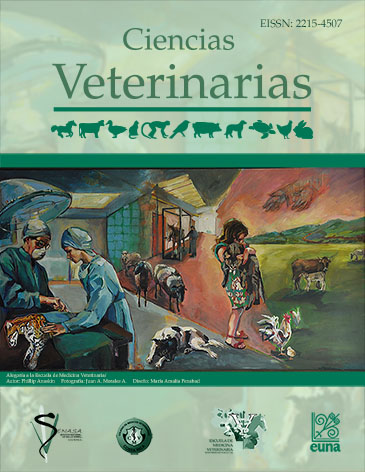Preliminary study on the presence of bee diseases in swarms of Africanized honey bees (Apis mellifera) in different areas of Costa Rica
DOI:
https://doi.org/10.15359/rcv.37-1.2Keywords:
swarms, Africanized honey bees, varroosis, nosemosis, acariasisAbstract
The presence of bee diseases was studied in 34 swarms of Africanized honey bees, recently established in different geographic areas of Costa Rica. One hundred adult bees were collected from the brood chamber of each swarm in a plastic container containing 70.0% alcohol to preserve them until the analysis. Bees were processed at the Bee Pathology Lab of the Tropical Beekeeping Research Center (CINAT-UNA), where samples were tested for varroosis, nosemosis, and acariosis. Based on the study conducted, recently established swarms of Africanized honey bees had the presence of varroosis and nosemosis, but no acariasis. From the samples that tested positive for varroosis, 41.0% showed a low level of infestation, with 2.0 ± 0.05 (mites/100 bees), while only 6.0% had a high level. In addition, from the samples that tested positive for Nosema spp, 26.0% showed a very low level of infection, while 18.0% had a low level. No high or moderate levels of infection were observed for Nosema spp. Given that most beekeepers catch and introduce swarms directly to the apiary, they are recommended to quarantine swarms and make laboratory analyses to know their health condition. This will allow for immediate actions to control diseases and, consequently, prevent contamination of healthy colonies in the apiary.
References
Anderson, D. L., & Trueman, J. W. 2000. Varroa jacobsoni (Acari: Varroidae) is more than one species. Exp. Appl. Acarol. 24: 165-189. Doi: 10.1023/A:1006456720416
Bailey, L., & Ball, B. 1991. Honey Bee Pathology. 2.a ed. Academic Press. London, UK. 193 p.
Bark, B., Wilde, J., & Siuda, M. 2018. The condition of honey bee colonies (Apis mellifera) treated for Varroa destructor by different methods. J. Apic. Res. 57: 674-681. Doi: 10.1080/00218839.2018.1495440
Biganski, S., Kurze, C., Muller, M., & Moritz, R. 2018. Social response of healthy honeybees towards Nosema ceranae-infected workers: care or kill? Apidologie 49: 325-334. Doi: 10.1007/s13592-017-0557-8
Botta, E., Carmenate, H., & De la Torre, P. 2004. Varroasis peligrosa enfermedad de la abeja melífera. Fitosanidad 1: 73-79.
Bravo, J., Carbonell, V., Valdebenedito, J. T., Figueroa, C., Valdovinos, C. E., Martín-Hernández, R., Higes, M., & Delporte, C. 2014. Identification of Nosema ceranae in the Valparaíso District, Chile. Arch. Med. Vet. 46: 487-491. Doi/site: www.redalyc.org/pdf/1730/173033278021
Calderón, R., Arce, H., Ortiz, R., Van Veen, J., & Ramírez, M. 2002. Varroa mites in Costa Rica: Treatment and Perspectives in Tropical Climates. Proceedings of the 2nd International Conference on Africanized Honey Bees and Bee Mites, Tucson, Arizona, U.S. Pp.177-180.
Calderón, R., Fallas, N., & Sánchez, L. 2007. Detección de enfermedades en abejas africanizadas en Costa Rica. Cienc. Vet. 25(2): 335-348. Doi/site: www.revistas.una.ac.cr/index.php/veterinaria/article/view/3676
Calderón, R., & Ramírez, F. 2010. Enfermedades de las abejas melíferas, con énfasis en abejas africanizadas. EUNA. Heredia, C. R. 137 p.
Calderón, R., & Pichardo, J. 2011. Nosemiasis en abejas melíferas: diagnóstico, control y prevalencia. CINAT-UNA. Heredia, C. R. 45 p.
Calderón, R., & Sánchez, L. 2011. Diagnóstico de enfermedades en colmenas de abejas africanizadas en Costa Rica: prevalencia y distribución de setiembre a noviembre del 2007. Agron. Costarricense 35(2): 49-60. Doi/site: https://revistas.ucr.ac.cr/index.php/agrocost/article/view/6678
Calderón, R., Fallas, N., & Ramírez, M. 2017. Comportamiento del ácaro Varroa destructor en celdas, con cría de obrera, de abejas africanizadas (Apis mellifera). Cienc. Vet. 35(2): 113-129. Doi: 10.15359/rcv.35-2.5
Cepero, A., Martín-Hernández, R., Prieto, L., Gómez-Moracho, T., Martínez-Salvador, A., Bartolomé, C., Maside, X., Meana, A., & Higes, M. 2015. Is Acarapis woodi a single species? A new PCR protocol to evaluate its prevalence. Parasitol. Res. 114(2): 651-8. Doi: 10.1007/s00436-014-4229-6
Crane, E. 1990. Bees and beekeeping: science, practice and world resources. Heinemann Newnes. London, UK. 614 p.
De Jong, D. 1997. Varroa and other parasites of brood. En Morse, R., & Flotum, K. (Eds). Honey bee pests, predators, and diseases. 3.a ed. A. I. Root Company. Ohio, USA. Pp. 280-327.
Delmiglio, C., Hai Fan, Q., George, S., Ward, L., Budge, G., Flynn, A., & Kumarasinghe, L. 2015. Development and evaluation of a real-time PCR assay for the detection of Acarapis woodi (tracheal mites) in Apis mellifera. Apidologie: 1-12. Doi: 10.1007/s13592-015-0420-8
Ellis, J., Evans, J., & Pettis, J. 2010. Colony losses, managed colony population decline, and Colony Collapse Disorder in the United States. J. Apic. Res. 49: 134-136. Doi: 10.3896/IBRA.1.49.1.30
Espina, D., & Ordetx, G. 1984. Apicultura tropical. Tecnológica de Costa Rica. Cartago, CR. 506 p.
Fries, I., & Camazine, S. 2001. Implications of horizontal and vertical pathogen transmission for honey bee epidemiology. Apidologie 32: 199-214. Doi: 10.1051/apido:2001122
Guzmán-Novoa, E., Correa, A., Espinosa, L., & Guzmán, G. 2011. Colonización, impacto y control de las abejas melíferas africanizadas en México. Vet. Méx. 42: 149-178.
Harbo, J., & Harris, J. 2005. Suppressed mite reproduction explained by the behavior of adult bees. J. Apic. Res. 44: 21-23. Doi: 10.1080/00218839.2005.11101141
Higes, M., Martin, R., & Meana, A. 2006. Nosema ceranae, a new microsporidian parasite in honey bees in Europe. J. Invertebr. Pathol. 92: 93-95. Doi: 10.1016/j.jip.2006.02.005
Junkes, L., Vieira, J., Guerra, J., & Moretto, G. 2007. Varroa destructor mite mortality rate according to the amount of worker brood in Africanized honey bee (Apis mellifera L.) colonies. Acta Sci. Biol Sci. 29: 305-308. Doi/site: www.redalyc.org/html/1871/187115762010/
Neumann, P., & Carreck, N. 2010. Honey bee colony losses. J. Apic. Res. 49: 1-6. Doi: 10.3896/IBRA.1.49.1.01
Martínez, J., Medina, L., & Catzín, G. 2011. Frecuencia de Varroa destructor, Nosema apis y Acarapis woodi en colonias manejadas y enjambres silvestres de abejas (Apis mellifera) en Mérida, Yucatán, México. Rev. Mex. Cienc. Pecu. 2: 25-38.
Medina, C., Guzmán, E., Hamiduzzaman, M., Aréchiga, C., & López, M. 2014. Africanized honey bees (Apis mellifera) have low infestation levels of the mite Varroa destructor in different ecological regions in Mexico. Genet. Mol. Res. 13: 7282-7293. Doi: 10.4238/2014.February.21.10
Molina, A., Guzmán, E., Message, D., De Jong, D., Pesante, D., Mantilla, C., Zozaya, A., Jaycox, E., Alvarado, F., Handal, S., & Meneses, G. 1990. Enfermedades y plagas de la abeja melífera occidental. OIRSA-BID. San Salvador, SV. 147 p.
Moretto, G., & Leonidas, J. 1999. Varroa jacobsoni infestation of adult Africanized and Italian honey bees (Apis mellifera) in mixed colonies in Brazil. Genet. Mol. Biol. 22: 321-323. Doi: 10.1590/S1415-47571999000300006
Ritter, W. 2001. Enfermedades de las abejas. Acribia. Zaragoza, ES. 146 p.
Royce, L., Rossignol, P., Burgett, D., & Stringer, B. 1991. Reduction of tracheal mite parasitism of honey bees by swarming. Philos. Trans. Biol. Sci. 331: 123-129.
Sakamoto, Y., Maeda, T., Yoshiyama, M., & Pettis, J. 2017. Differential susceptibility to the tracheal mite Acarapis woodi between Apis cerana and Apis mellifera. Apidologie 48: 150-158. Doi: 10.1007/s13592-016-0460-8
Shimanuki, H., & Knox, D. 1991. Diagnosis of Honey Bee Diseases. Department of Agriculture. US. 53 p.
Spivak, M., Fletcher, J., & Breed, M. 1991. The “African” Honey Bee. Westview. US. 435 p.
Spivak, M., & Reuter, G. 2001. Varroa destructor infestation in untreated honey bee (Hymenoptera: Apidae) colonies selected for hygienic behavior. J. Econ. Entomol. 94: 326-331. Doi: 10.1603/0022-0493-94.2.326
Szalanski, A., Tripodi, A., & Trammel, C. 2014. Molecular detection of Nosema apis and N. Ceranae from Southwestern and South-Central USA Feral Africanized and European honey bees, Apis mellifera (Hymenoptera: Apidae). Fla. Entomol. 97: 585-589. Doi: 10.1653/024.097.0233
Traver, B., & Fell, R. 2011. Prevalence and infection intensity of Nosema in honey bee (Apis mellifera L.) colonies in Virginia. J. Invertebr. Pathol. 107: 43-49. Doi: 10.1016/j.jip.2011.02.003
Wilde, J., Fuchs, S., Bratkowski, J., & Siuda, M. 2005. Distribution of Varroa destructor between swarms and colonies. J. Apic. Res. 44(4): 190-194. Doi: 10.1080/00218839.2005.11101177
Published
How to Cite
Issue
Section
License
Licensing of articles
All articles will be published under a license:

Licencia Creative Commons Atribución-NoComercial-SinDerivadas 3.0 Costa Rica.
Access to this journal is free of charge, only the article and the journal must be cited in full.
Intellectual property rights belong to the author. Once the article has been accepted for publication, the author assigns the reproduction rights to the Journal.
Ciencias Veterinarias Journal authorizes the printing of articles and photocopies for personal use. Also, the use for educational purposes is encouraged. Especially: institutions may create links to specific articles found in the journal's server in order to make up course packages, seminars or as instructional material.
The author may place a copy of the final version on his or her server, although it is recommended that a link be maintained to the journal's server where the original article is located.
Intellectual property violations are the responsibility of the author. The company or institution that provides access to the contents, either because it acts only as a transmitter of information (for example, Internet access providers) or because it offers public server services, is not responsible.







